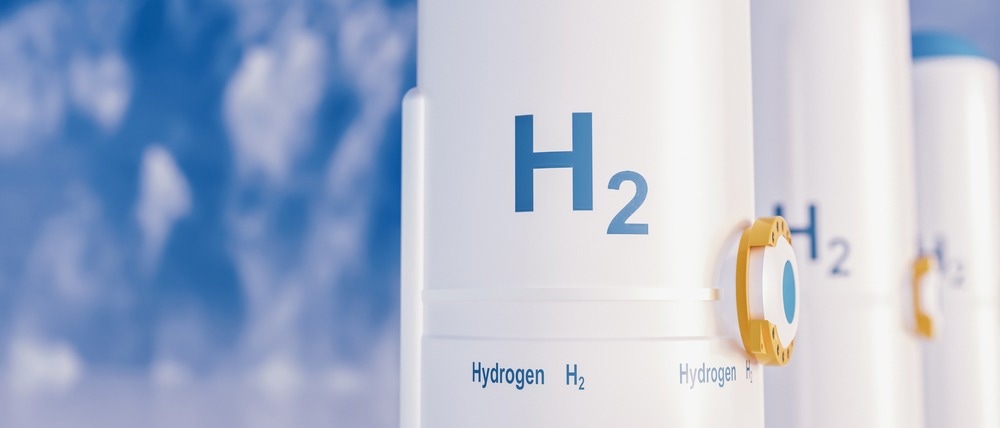Nanocrystal arrays with precise subnanometer distances can be used to develop novel materials that increase the scope of future applications. Nevertheless, it is not easy to develop aligned nanocrystal arrays with precision at the subnanometer range, using conventional methods.

Study: Coupling of nanocrystal hexagonal array and two-dimensional metastable substrate boosts H2-production. Image Credit: Audio und werbung/Shutterstock.com
A recent Nature Communications study reported the fabrication of a two-dimensional (2D) layered metastable oxide, i.e., trigonal phase rhodium oxide, which serves as a platform for the fabrication of well-ordered, hexagonal patterned, face-centered cubic rhodium nanocrystal arrays to boost hydrogen production.
Electrochemical Catalysts for Hydrogen Production
One of the major advancements related to hydrogen production is the development of effective electrochemical catalysts for hydrogen evolution reactions (HER).
In the industry, hydrogen is mainly required for energy storage and conversion. Simple HER is a less advanced process, having many limitations, including its inability to define water catalytic reaction.
Trassati’s volcano plot has indicated rhodium (Rh) or Rh-based materials to be potential catalysts for HER. However, a key disadvantage related to the utilization of Rh for the formation of H2 includes the high adsorption energy of hydrogen (ΔGH) on the Rh surface. Additionally, the poor durability of Rh-based materials urges the need for better structural design to achieve effective HER performance.
How do the Arrangements of Nano-sized Components Influence the Electronic and Transport Properties of Materials?
The impact of precisely ordered nano-sized components on the transport and electronic properties of the material has been documented in several studies. The periodic identical arrays of nano-sized entities impart unique properties to the material that are different from its corresponding bulk structures.
Many nanostructures with periodic alignment have been identified, which can be applied in catalysis, energy conversion, and photoelectronic devices. Although an accurately patterned nanocrystal array with an interparticle gap of a few nanometres could be extremely advantageous, the conventional nanolithography methods cannot yield interparticle gaps smaller than 10 nanometers. Hence, there is a need for a new fabrication strategy that can develop an accurately aligned nanocrystal array with an interparticle distance below 5 nanometers.
Characteristic Features of 2D Metastable Metal Oxides
2D metastable metal oxides have been determined to be an ideal substrate that can overcome the challenges discussed above. Some of the important characteristic features of 2D materials that have increased their applicability include maximum atomic utilization, desirable durability, and ideal activities.
Owing to intrinsic metastable properties, metastable metal oxides could be used to fabricate interfacial structures. Importantly, the hydrogen spillover effect associated with the metal oxide catalytic interfacial system can promote the migration of the activated hydrogen atoms from a region of high hydrogen concentration to a region of low hydrogen concentration. This phenomenon could be used to improve HER function.
Accurate Alignment of Nanocrystal Array on 2D Metastable Trigonal Rhodium oxide (P-Tri-RhO2)
Recently, scientists have accurately aligned nanocrystals on 2D P-Tri-RhO2, which was fabricated using a radiofrequency-based molten-alkali method, where potassium hydroxide (KOH) and rhodium (III) chloride (RhCl3) were selected as raw materials.
P-Tri-RhO2 was characterized using various analytical tools, such as transmission electron microscopy (TEM), scanning electron microscopy (SEM), atomic force microscopy (AFM), X-ray diffraction (XRD), and X-ray spectroscopy (EDX). SEM and TEM analysis revealed the 2D ultrathin nanosheet morphology of P-Tri-RhO2.
Based on selected area electron diffraction (SAED) pattern analysis, the structure of P-Tri-RhO2 was found to be hexagonal. AFM analysis revealed that P-Tri-RhO2 was around 1.39 nanometers thick. XRD confirmed the crystalline structure of P-Tri-RhO2 and the crystalline parameters were determined to be a = b = 3.091 Å and c = 4.407 Å. EDX analysis revealed uniform distribution of Rh and O in P-Tri-RhO2. The space between two neighboring Rh atoms was found to be 0.31 nanometers.
The newly developed crystal structure was classified as space group P-3m1 (164). Electrochemical reduction of P-Tri-RhO2 via chronoamperometry method fabricated well-aligned nanocrystal arrays (Rh-NA/RhO2). XRD analysis revealed the presence of a small amount of metallic Rh in Rh-NA/RhO2.
The electrochemical specific surface area (ECSAs) of Rh-NA/RhO2 indicated the in situ formation of Rh nanoparticles on the P-Tri-RhO2 substrate. An alteration of 0.45% lattice between face-centered cubic (fcc) phase Rh and metastable P-Tri-RhO2 promoted an in situ growth of Rh single-crystal nanoarrays whose interparticle gap was 3.709 nanometers.
Density functional theory (DFT) was used to study the underlying HER enhancement mechanism based on the interface structure of Rh-NA/RhO2. This analysis revealed that hydrogen spillover ultimately increased HER process in the Rh-NA/RhO2 system. The nanoscale spacing between Rh single-crystal nanoarrays promoted hydrogen atoms spillover, significantly improving the HER function. An ultralow overpotential of 9.8 mV was achieved at a current density of −10 mA cm−2. Additionally, a low Tafel slope of 24.0 mV dec−1 was observed along with minimal activity decay when subjected to a high potential of −0.4 V.
In summary, trigonal phase RhO2 served as an excellent precursor for developing a well-aligned nanocrystal array with an intersurface distance of 0.5 nm. Coupling between the 2D metastable substrate and the nanocrystal array promoted effective hydrogen spillover, enhancing HER. This newly formed, well-ordered nanocrystal array could be extensively used for future applications.
Reference
Fan, Z., Liao, F., Ji, Y. et al. (2022) Coupling of nanocrystal hexagonal array and two-dimensional metastable substrate boosts H2-production. Nature Communications. 13, 5828. https://www.nature.com/articles/s41467-022-33512-5
Disclaimer: The views expressed here are those of the author expressed in their private capacity and do not necessarily represent the views of AZoM.com Limited T/A AZoNetwork the owner and operator of this website. This disclaimer forms part of the Terms and conditions of use of this website.